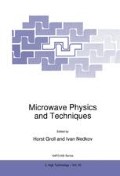Abstract
As it has been shown in [1], the tropospheric duct may affect significantly the wideband propagation due to the different conditions the frequencies of an, even narrow, range propagate in this case. The wideband distortion may be of particular importance for short pulse radar systems or high bit rate communication systems. In this report the influence of the commonly occurring evaporation ducts has been studied for two frequency bands: 10–12 GHz and 17–18 GHz. A path loss prediction program, described and validated in [2, 3], has been used to calculate the propagation channel transfer function (field strength relative to free space as a function of frequency) in the presence of a homogeneous evaporation duct.
Access this chapter
Tax calculation will be finalised at checkout
Purchases are for personal use only
Preview
Unable to display preview. Download preview PDF.
References
Craig, K. H. and Levy, M. F. (1989) A forecasting system using the parabolic equation — application to surface-to-air propagation in he presence of elevated layers, In: Proceedings of the 1989 San Diego USA AGARD 44th EPP Symposium, 20/1–20/12.
Sirkova, I. D. (1995) On microwave propagation prediction under lower troposphere ducting conditions, Compt. rend. Acad. bulg. Sci. 48, 23–25.
Sirkova, I. D. (1996) A clear-air propagation prediction system: evaporation duct application, Bulgarian J. Phys. 23, in press.
Dorfman, N. A., Kabanov, V. A., Kiwa, F. V., and Tourgenev, I. S. (1978) Refractive index statistical characteristics in above the see layer, Izv. Acad. of Sci. SSSR Fizika Atmosferi i Okeana 14, 549–553 (in russian)
Craig, K. H. and Levy, M. F. (1989) Field strength forecasting with the parabolic equation: wideband applications, In: IEE Conf.Proc. 301, 461–465.
Author information
Authors and Affiliations
Editor information
Editors and Affiliations
Rights and permissions
Copyright information
© 1997 Springer Science+Business Media Dordrecht
About this chapter
Cite this chapter
Sirkova, I.D. (1997). On Tropospheric Channel Transfer Function Under Ducting Conditions. In: Groll, H., Nedkov, I. (eds) Microwave Physics and Techniques. NATO ASI Series, vol 33. Springer, Dordrecht. https://doi.org/10.1007/978-94-011-5540-3_37
Download citation
DOI: https://doi.org/10.1007/978-94-011-5540-3_37
Publisher Name: Springer, Dordrecht
Print ISBN: 978-94-010-6333-3
Online ISBN: 978-94-011-5540-3
eBook Packages: Springer Book Archive

